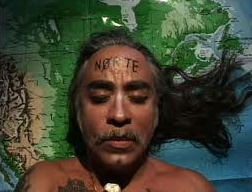Guillermo Gómez-Peña
From Geography
Guillermo Gómez-Peña is an artist, writer, activist, performer and educator, who can be seen as a postmodernist. Gómez-Peña was born in 1955 in Mexico-city, until the age of 23 he stayed in Mexico, after which he decided to move to the United States in 1978. After his movement he became interested and obsessed by the Mexican-American border and intercultural differences, which were fuelled through his own experiences. During his career this topics remained his main focus. Together with Gloria Anzaldua and Bell hooks, Gómez-Peña belongs to an influential group of American postmodernists whose focus is mainly on the minority groups in the U.S. (such as chicano's, blacks and latino's).
“The performance is never over for us. No matter how much we understand that ethnic identity is a cultural and ideological construction, and that as performance artists we have the power to alter it at will, nevertheless, we are always confronted in the most unexpected moments by the guardians of fetishized identity and the enforcers of stereotype” (Guillermo Gómez-Peña, in Not in your museum, 2010)
Contents |
His work
The work of Gómez-Peña can be placed in the wave of the post-modernism. Postmodernists don't believe in one absolute truth, through life-experiences and personal visions people create their own personal truth. Besides they strive for equality, differences between people are too big. Postmodernists are concerned about the world, the way people use this world and how people interact with each other is wrong. These characteristics emerge strongly in the work of Gómez-Peña. His work work is mainly based on the interface of the North and South border between Mexico and the United States and the so called Chicano’s and Chicana’s, a large group of American citizens with Mexican roots, who are a separated group within the United States. Through his interdisciplinary and multimedia performance art Gómez-Pena simultaneously inscribes and transgresses geopolitical, cultural, linguistic and aesthetic borders. He performs between two nations, perforates the conceptual border line between them and simultaneously interrogates the fictional cohesiveness of both nations (Neustadt, 1999, p.131).
Gómez-Peña’s unconventional texts demonstrate how performance art can be used as a instrument to influence the politics. Besides a way to spread ideals and criticize the established political order, he tries to draw attention to complex notions of cultural, political and discursive borders. With the use of art, paintings, writings and other ways of performances he tries to redraw boundaries.
Gomez-Peña started the la Pocha nostra, an arts collective consistent of intercultural, cross-border collaborations with performance artists of many countries. This organization transcends the subject of Mexican-American border and differences between the cultures. La Pocha nostra is an organization of citizens focussed on the notion of collaboration across borders, gender, generations and race. An organization in which transnational collaborations between rebel artists occurs, who believe that the periphery is the centre (O. Kramsch, hoorcollege Chicano/a & Black Postmodernism, Nijmegen, 9 oktober 2012).
Works
- The son of border Brujo (1989)
- New world border (1997)
- Borderstasis (1998)
- El Naftazteca: Cyber-Aztec (2000)
- Border iractures (2000)
- The great mojado invasion
Useful links
- www.pochanostra.com
References
- Neustadt, R. (1999). (Con)Fusing signs and postmodern positions. Spanish American performance, experimental writing and the critique of political confusion. Garland Publishing Inc.: New York.
- Not in your Museum. (2010). LA NOSTALGIA:WE Guillermo Gomez-Pena. Found on 25 Octobre 2012, on http://nomuseum.wordpress.com/2010/07/05/la-nostalgiawe-guillermo-gomez-pena/
Contributors
- Page created by Lars Paardekooper 23 October 2012
- Page edited by Anke Janssen, on 25 Octobre 2012
- Picture added by --AnneStrien 11:58, 26 October 2012 (CEST)
- Page edited by --AnneStrien 12:09, 26 October 2012 (CEST)
